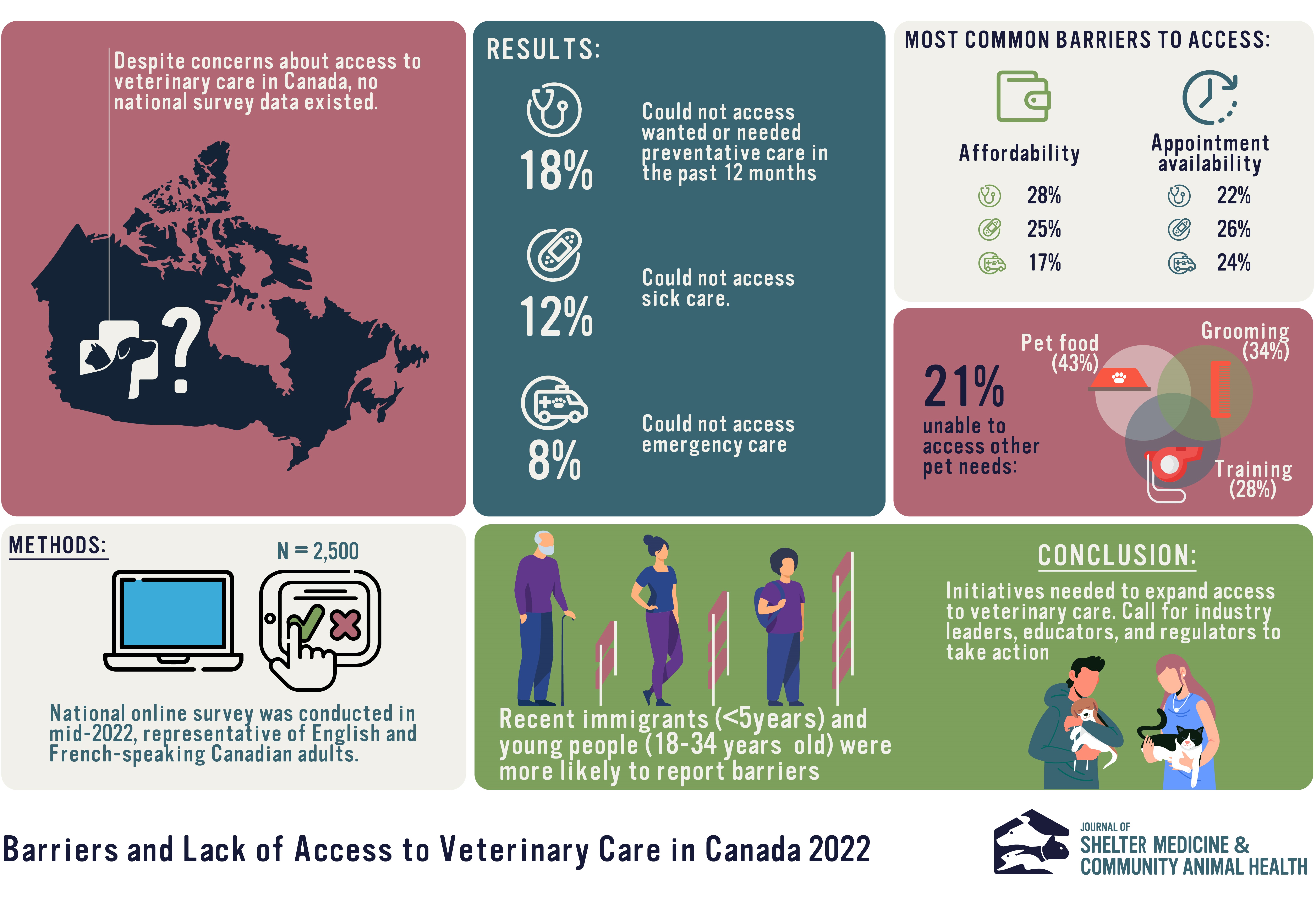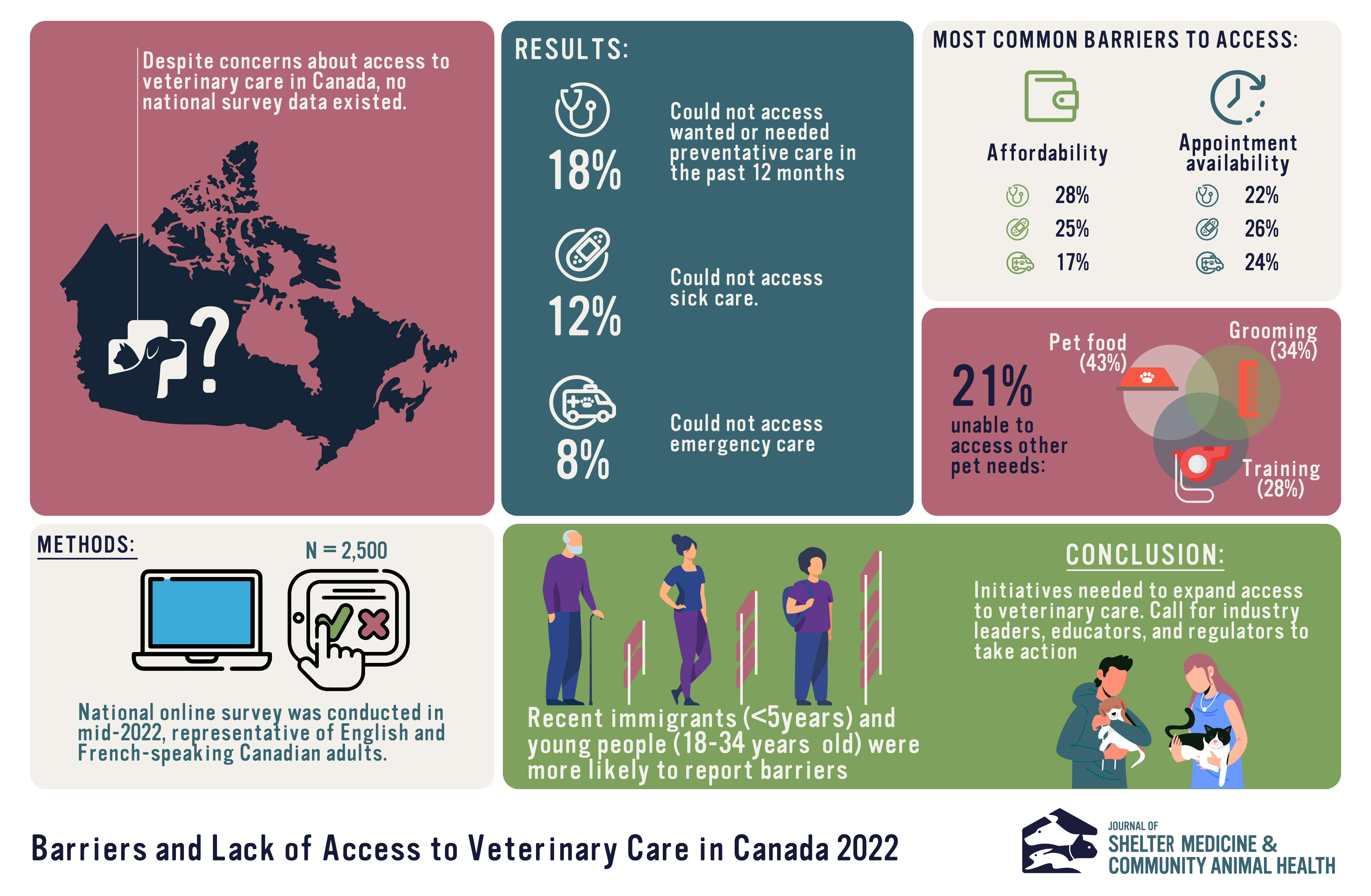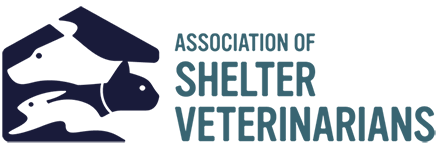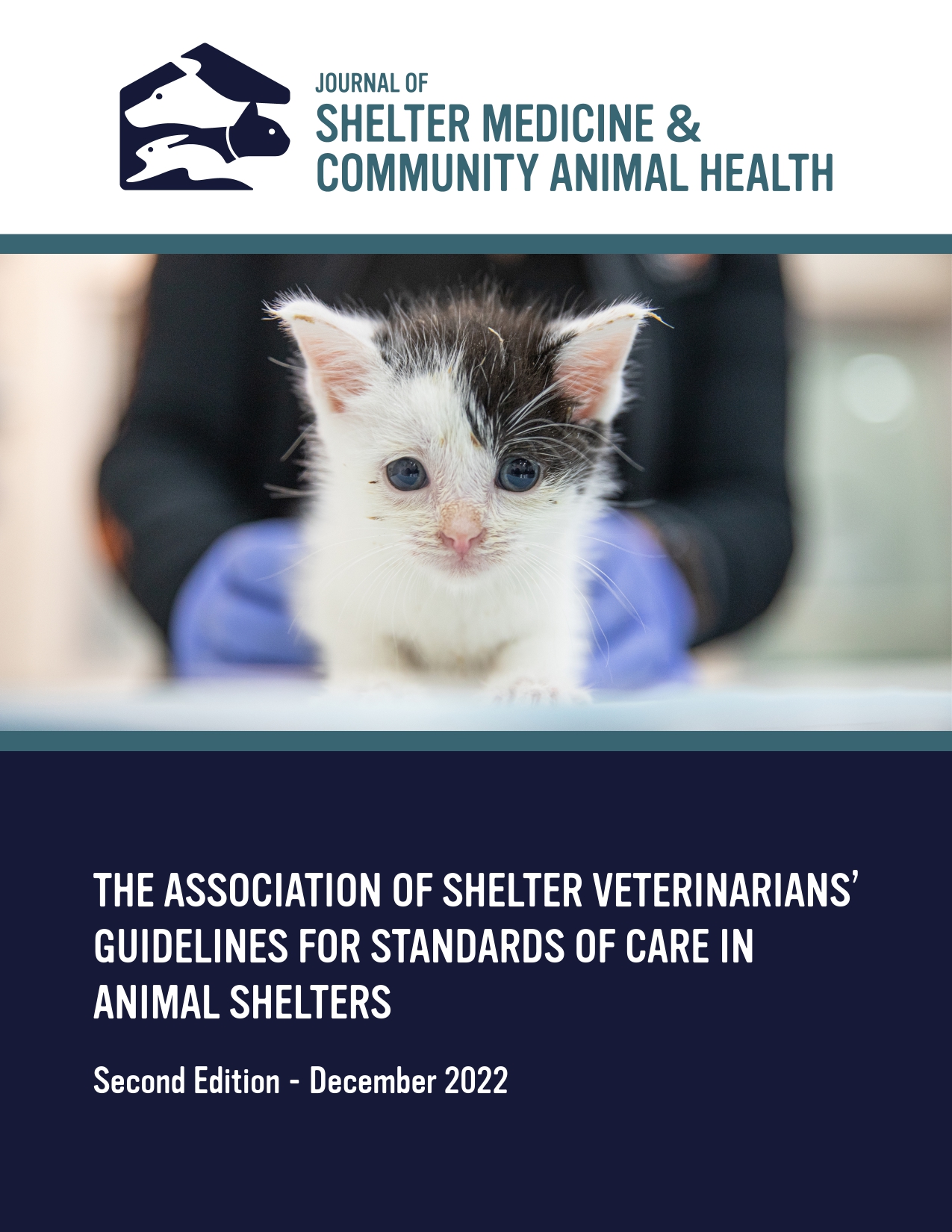Barriers and Lack of Access to Veterinary Care in Canada 2022
DOI:
https://doi.org/10.56771/jsmcah.v3.72Keywords:
accessible veterinary care, access to care, barriers to care, non-medical pet care, online survey, nationwide, CanadaAbstract
Introduction: Despite concerns about access to veterinary care in Canada, there are no previously published national survey data. The study aimed to estimate the prevalence of barriers to veterinary care faced by Canadian dog and cat owners, and to identify associated factors.
Methods: This was a national online survey conducted in mid-2022, the third year of the COVID-19 pandemic. It was nationally representative of English and French-speaking Canadian adults as regards region, age, and sex.
Results: Eighteen per cent of the respondents (440/2,500) could not access wanted or needed preventative veterinary care in the past 12 months; 12% (305/2,500) could not access sick care; and 8% (195/2,500) could not access emergency care. The most frequent barriers were the inability to afford care (preventative – 124/440, 28% of those who were unable to access care; sick – 75/305, 25%; emergency – 34/195, 17%); and the inability to obtain an appointment (preventative – 95/440, 22% of those who were unable to access care; sick – 80/305, 26%; emergency – 47/195, 24%). Twenty-one per cent (522/2,500) could not access other pet needs, most frequently pet food (43% of those who lacked access); grooming (34%); and training (28%). Recent immigrants (<5 years) and young people (18–34 years old) were more likely to report barriers. Affordability and appointment availability were the two most frequently occurring barriers.
Conclusions: This survey identified a large number of pet owners who faced barriers to veterinary care. There is a need for industry leaders, educators and regulators to help support initiatives to expand access to care.

Downloads
References
Harding MJ. Access to veterinary care for low-income Canadians. Can Vet J. 2018;59(10):1121–1122.
Lavallee E, Mueller MK, McCobb E. A systematic review of the literature addressing veterinary care for underserved communities. J Appl Anim Welf Sci. 2017;20:1–14. doi: 10.1080/10888705.2017.1337515
Lem M. Barriers to accessible veterinary care. Can Vet J. 2019;60:891–893.
Stull JW, Shelby JA, Bonnett BN, et al. Barriers and next steps to providing a spectrum of effective health care to companion animals. J Am Vet Med Assoc. 2018;253(11):1386–1389. doi: 10.2460/javma.253.11.1386
Einav L, Finkelstein A, Gupta A. Is American pet health care (also) uniquely inefficient? Am Econ Rev. 2017;107(5):491–495. doi: 10.1257/aer.p20171087
Neal SM. Correlating access to primary medical care and veterinary care providers: a novel application of spatial gravity modelling. Vet Sci. 2023;10(9):1–11. doi: 10.3390/vetsci10090565
Neal SM, Greenberg M. Veterinary care deserts: what is the capacity and where is it? J Shelter Med Community Anim Health. 2022;1(1):1–8. doi: 10.56771/jsmcah.v1.2
Roberts C, Woodsworth J, Carlson K, Reeves T, Epp T. Defining the term “underserved:” a scoping review towards a standardized description of inadequate access to veterinary services. Can Vet J. 2023;64(10):941–950.
Blackwell MJ, O’Reilly A. Access to veterinary care–a national family crisis and case for one health. Adv Small Anim Care. 2023;4(1):145–157. doi: 10.1016/j.yasa.2023.05.003
Park RM, Gruen ME, Royal K. Association between dog owner demographics and decision to seek veterinary care. Vet Sci. 2021;8(1):1–19. doi: 10.3390/VETSCI8010007
Wiltzius A, Blackwell M, SB K, et al. Access to Veterinary Care: Barriers, Current Practices, and Public Policy. 2018. https://avcc.utk.edu/avcc-report.pdf. Accessed September 26, 2019.
Neal SM, Greenberg MJ. Putting access to veterinary care on the map: a veterinary care accessibility index. Front Vet Sci. 2022;9:1–8. doi: 10.3389/fvets.2022.85764413
Veterinary Care Accessibility Project. The Veterinary Care Accessibility Score. 2022. https://www.accesstovetcare.org/vcas-map. Accessed August 3, 2023.
Smith SM, George Z, Duncan CG, Frey DM. Opportunities for expanding access to veterinary care: lessons from COVID-19. Front Vet Sci. 2022;9:1–20. doi: 10.3389/fvets.2022.804794
Owczarczak-Garstecka SC, Furtado T, Graham TM, et al. Impacts of COVID-19 on owner’s veterinary healthcare seeking behavior for dogs with chronic conditions: an exploratory mixed-methods study with a convenience sample. Front Vet Sci. 2022;9:1–20. doi: 10.3389/FVETS.2022.902219
CM Research. COVID-19: Global Pandemic Impact on the Veterinary Market. 2021. https://www.canadianveterinarians.net/media/bftkzksf/vet-survey-2020-part-1-covid-19-global-pandemic-impact-on-the-veterinary-market.pdf. Accessed July 3, 2023.
Evason M, Stein M, Stull J. Impact of a spectrum of care elective course on third-year veterinary students’ self-reported knowledge, attitudes, and competencies. J Vet Med Educ. 2022;50:590–598. doi: 10.3138/jvme-2022-0010
College of Veterinarians of Ontario. Position Statement: Balancing Available Health Care Options and Client Access to Veterinary Care. 2022:1–3. https://www.cvo.org/standards/balancing-available-health-care-options-and-client-access-to-veterinary-care. Accessed August 30, 2023.
Brown CR, Edwards S, Kenney E, et al. Family quality of life: pet owners and veterinarians working together to reach the best outcomes. J Am Vet Med Assoc. 2023;261(8):1238–1243. doi: 10.2460/javma.23.01.0016
Englar RE. Recasting the gold standard – part I of II: delineating healthcare options across a continuum of care. J Feline Med Surg. 2023;25(12):1–11. doi: 10.1177/1098612X231209855
Statistics Canada. Distributions of Household Economic Accounts for Income, Consumption and Saving of Canadian Households, Second Quarter 2022. https://www150.statcan.gc.ca/n1/daily-quotidien/221003/dq221003b-eng.htm. Accessed December 11, 2023.
Statistics Canada 2023. Canadian Income Survey, 2021. 2023. https://www150.statcan.gc.ca/n1/daily-quotidien/230502/dq230502a-eng.htm?indid=11361-1&indgeo=0. Accessed December 11, 2023.
Nichols PJH, Ward KA, Janke KJ, Jacobson LS. Trends in companion animal access to veterinary care in Canada, 2007–2020. Can Vet J. 2024:65(1):49–58
Muzzatti SL, Grieve KL. Covid cats and pandemic puppies: the altered realm of veterinary care for companion animals during a global pandemic. J Appl Anim Welf Sci. 2022;25(2):153–166. doi: 10.1080/10888705.2022.2038168
Baker T, Rock M, Bondo K, van der Meer F, Kutz S. 11 Years of regular access to subsidized veterinary services is associated with improved dog health and welfare in remote Northern communities. Prev Vet Med. 2021;196:105471. doi: 10.1016/j.prevetmed.2021.105471
Canadian Animal Health Institute. Canadian Pet Ownership 2022, August 12, 2022:1–46.
Statistics Canada. Census Profile, 2021 Census of Population. 2021. https://www12.statcan.gc.ca/census-recensement/2021/dp-pd/prof/details/page.cfm?Lang=E&DGUIDList=2021A000011124&GENDERList=1&STATISTICList=1&HEADERList=0&SearchText=Canada. Accessed August 18, 2023.
Ontario Veterinary Medical Association. Ontario Pet Owners Report. 2023. https://www.ovma.org/assets/1/6/2023 Pet Owners Report.pdf. Accessed January 11, 2024.
Doherty. A strong year for Canadian veterinarians: results of the 2021 CVMA Practice Owners Economic Survey. Can Vet J. 2022. https://pubmed.ncbi.nlm.nih.gov/35784771/. Accessed September 28, 2022.
Ontario Veterinary Medical Association. Practice Survey Results. 2020. https://www.ovma.org/assets/1/6/NewsHound_April-20-Final.pdf. Accessed July 18, 2023.
Canadian Veterinary Medical Association. CVMA Workforce Study Final Report. May 2020:1–79.
https://www.canadianveterinarians.net/media/ak3lonad/2020-cvma-workforce-study-final-report.pdf. Accessed October 10, 2022.
Canadian Veterinary Medical Association. Expanding Veterinary Medicine Capacity 2022–2032: Report of the Canadian Veterinary Medical Association Veterinary Workforce Congress 2022. 2022. https://www.canadianveterinarians.net/media/5m1dvtwy/expanding-veterinary-medicine-capacity-in-canada-2022-2032-final.pdf. Accessed May 16, 2023.
Statistics Canada. Immigrants Make up the Largest Share of the Population in Over 150 Years and Continue to Shape Who We Are as Canadians. https://www150.statcan.gc.ca/n1/daily-quotidien/221026/dq221026a-eng.htm. Accessed June 30, 2023.
Statistics Canada. Canada at a glance: Racialized groups. 2022. https://www150.statcan.gc.ca/n1/pub/12-581-x/2022001/sec3-eng.htm. Accessed June 23, 2023.
Schurer JM, Phipps K, Okemow C, Beatch H, Jenkins E. Stabilizing dog populations and improving animal and public health through a participatory approach in Indigenous communities. Zoonoses Public Health. 2015;62(6):445–455. doi: 10.1111/zph.12173
Statistics Canada. Income of Men and Women, Sub-Provincial Regions. https://www150.statcan.gc.ca/n1/pub/71-607-x/71-607-x2019006-eng.htm. Accessed December 18, 2023.
Daigneault PM, Birch L, Béland D, Bélanger SD. Taking subnational and regional welfare states seriously: insights from the Quebec case. J Eur Soc Policy. 2021;31(2):239–249. doi: 10.1177/0958928721996651
Béland D, Dinan S, Rocco P, Waddan A. COVID-19, poverty reduction, and partisanship in Canada and the United States. Policy Soc. 2022;41(2):291–305. doi: 10.1093/polsoc/puac002
Arluke A. Coping with pet food insecurity in low-income communities. Anthrozoos. 2021;34(3):339–358. doi: 10.1080/08927936.2021.1898215
Ly LH, Gordon E, Protopopova A, Ly LH. Exploring the relationship between human social deprivation and animal surrender to shelters in British Columbia, Canada. Front Vet Sci. 2021;8:1–18. doi: 10.3389/fvets.2021.656597
Humane Canada. National Pet Food Bank Program. c2022.https://humanecanada.ca/national-pet-food-bank/. Accessed June 9, 2023.
International Council for Veterinary Assessment. NAVLE. c2023. https://www.icva.net/navle/. Accessed July 2, 2023.
American Veterinary Medical Association. ECFVG Relationship with the Canadian NEB. 2015. https://www.avma.org/education/ecfvg/ecfvg-policies-and-procedures/ecfvg-relationship-canadian-neb. Accessed July 2, 2023.
Burkinshaw. Income Inequality in Canada. 2022:1–33. https://www.bankofcanada.ca/2022/07/staff-discussion-paper-2022-16/. Accessed September 5, 2022.
Card C, Epp T, Lem M. Exploring the social determinants of animal health. J Vet Med Educ. 2018;45(4):437–447. doi: 10.3138/jvme.0317-047r
Human Animal Support Services. A Community-First Movement to Serve People and Pets Equally. 2023. https://www.humananimalsupportservices.org/. Accessed August 21, 2023.
Humane Canada [Canadian Federation of Humane Societies]. Humane Societies and SPCAs in Canada: A Comprehensive Look at the Sector. 2016. https://humanecanada.ca/wp-content/uploads/2020/03/CFHS-Sector_Report_-_EN_-_Final.pdf. Accessed January 11, 2024.
Veterinary Services in Canada – Market Size, Industry Analysis, Trends and Forecasts (2023–2028). 2023. https://www.ibisworld.com/canada/market-research-reports/veterinary-services-industry/. Accessed December 18, 2023.
Reese L, Li X. Animal welfare deserts: human and nonhuman animal inequities. Front Vet Sci. 2023;10:1–12. doi: 10.3389/fvets.2023.1189211
Canadian Institute for Healthcare Information. Canadian COVID-19 Intervention Timeline. 2022. https://www.cihi.ca/en/canadian-covid-19-intervention-timeline. Accessed June 29, 2023.

Additional Files
Published
Issue
Section
License
Copyright (c) 2024 Linda S. Jacobson, Kyrsten J. Janke, Kevin Probyn-Smith, Kate Stiefelmeyer

This work is licensed under a Creative Commons Attribution 4.0 International License.









